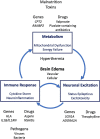Genetic and environmental risk factors of acute infection-triggered encephalopathy
- PMID: 36761411
- PMCID: PMC9902370
- DOI: 10.3389/fnins.2023.1119708
Genetic and environmental risk factors of acute infection-triggered encephalopathy
Abstract
Acute encephalopathy is a constellation of syndromes in which immune response, metabolism and neuronal excitation are affected in a variable fashion. Most of the syndromes are complex disorders, caused or aggravated by multiple, genetic and environmental risk factors. Environmental factors include pathogenic microorganisms of the antecedent infection such as influenza virus, human herpesvirus-6 and enterohemorrhagic Escherichia coli, and drugs such as non-steroidal anti-inflammatory drugs, valproate and theophylline. Genetic factors include mutations such as rare variants of the SCN1A and RANBP2 genes, and polymorphisms such as thermolabile CPT2 variants and HLA genotypes. By altering immune response, metabolism or neuronal excitation, these factors complicate the pathologic process. On the other hand, some of them could provide promising targets to prevent or treat acute encephalopathy.
Keywords: acute encephalopathy; drug; immune response; infection; metabolism; neuronal excitation; susceptibility gene.
Copyright © 2023 Mizuguchi, Shibata, Kasai and Hoshino.
Conflict of interest statement
The authors declare that the research was conducted in the absence of any commercial or financial relationships that could be construed as a potential conflict of interest.
Figures


Similar articles
-
Recurrent acute necrotizing encephalopathy in a boy with RANBP2 mutation and thermolabile CPT2 variant: The first case of ANE1 in Japan.Brain Dev. 2021 Sep;43(8):873-878. doi: 10.1016/j.braindev.2021.04.009. Epub 2021 May 28. Brain Dev. 2021. PMID: 34059398
-
Thermolabile polymorphism of carnitine palmitoyltransferase 2: A genetic risk factor of overall acute encephalopathy.Brain Dev. 2019 Nov;41(10):862-869. doi: 10.1016/j.braindev.2019.07.008. Epub 2019 Jul 24. Brain Dev. 2019. PMID: 31351739
-
Acute severe encephalopathy related to human herpesvirus-6 infection in a patient with carnitine palmitoyltransferase 2 deficiency carrying thermolabile variants.Brain Dev. 2013 May;35(5):449-53. doi: 10.1016/j.braindev.2012.06.013. Epub 2012 Jul 31. Brain Dev. 2013. PMID: 22854105
-
Acute encephalopathy associated with influenza and other viral infections.Acta Neurol Scand Suppl. 2007;186:45-56. Acta Neurol Scand Suppl. 2007. PMID: 17784537 Review.
-
Acute encephalopathy associated with influenza and other viral infections.Acta Neurol Scand. 2007 Apr;115(4 Suppl):45-56. doi: 10.1111/j.1600-0404.2007.00809.x. Acta Neurol Scand. 2007. PMID: 17362276 Review.
Cited by
-
Bioinformatics analysis identifies a key gene HLA_DPA1 in severe influenza-associated immune infiltration.BMC Genomics. 2024 Mar 7;25(1):257. doi: 10.1186/s12864-024-10184-7. BMC Genomics. 2024. PMID: 38454348 Free PMC article.
-
A Universal Aptamer for Influenza A Viruses: Selection, Recognition, and Infection Inhibition.ACS Pharmacol Transl Sci. 2023 Dec 29;7(1):249-258. doi: 10.1021/acsptsci.3c00258. eCollection 2024 Jan 12. ACS Pharmacol Transl Sci. 2023. PMID: 38230279 Free PMC article.
-
Association of IL6 and IL10 gene promotor polymorphisms with susceptibility to acute necrotizing encephalopathy.Front Neurosci. 2023 Aug 3;17:1231957. doi: 10.3389/fnins.2023.1231957. eCollection 2023. Front Neurosci. 2023. PMID: 37600000 Free PMC article.
-
CSF neopterin and quinolinic acid are biomarkers of neuroinflammation and neurotoxicity in FIRES and other infection-triggered encephalopathy syndromes.Ann Clin Transl Neurol. 2023 Aug;10(8):1417-1432. doi: 10.1002/acn3.51832. Epub 2023 Jun 20. Ann Clin Transl Neurol. 2023. PMID: 37340737 Free PMC article.
-
Predicting factors for acute encephalopathy in febrile seizure children with SARS-CoV-2 omicron variant: a retrospective study.BMC Pediatr. 2024 Mar 25;24(1):211. doi: 10.1186/s12887-024-04699-x. BMC Pediatr. 2024. PMID: 38528535 Free PMC article.
References
-
- Aledo-Serrano A., Hariramani R., Gonzalez-Martinez A., Álvarez-Troncoso J., Toledano R., Bayat A., et al. (2022). Anakinra and tocilizumab in the chronic phase of febrile infection-related epilepsy syndrome (FIRES): Effectiveness and safety from a case-series. Seizure 100 51–55. 10.1016/j.seizure.2022.06.012 - DOI - PubMed
Publication types
LinkOut - more resources
Full Text Sources
Research Materials
Miscellaneous

